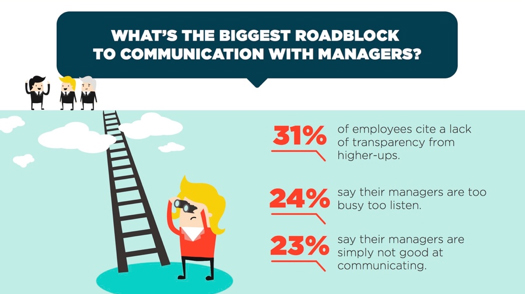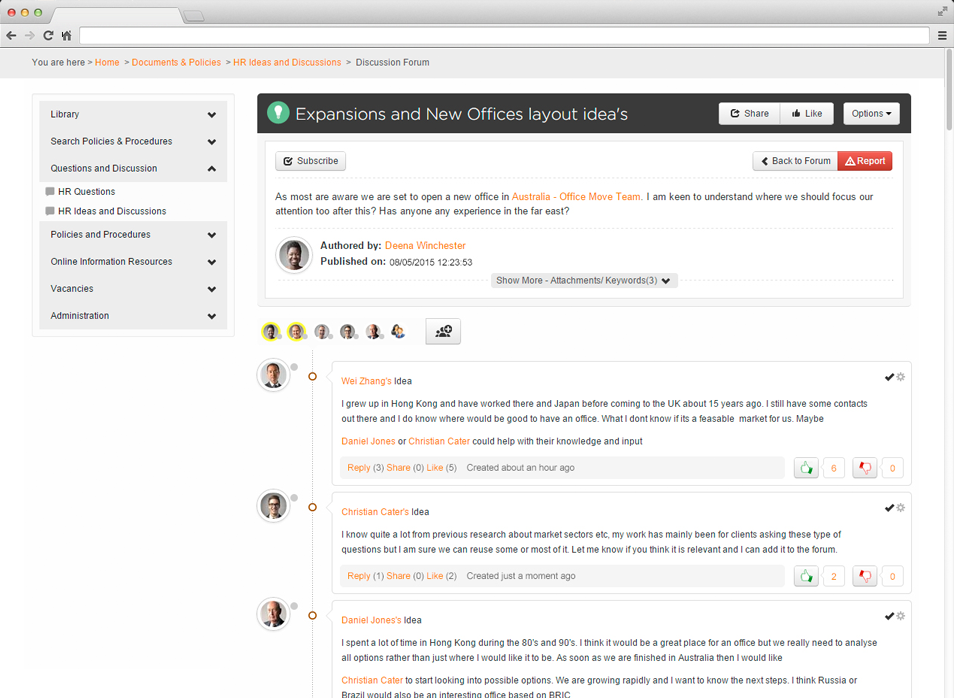Is the message getting through? 5 signs your workplace communications arent influencing employees
Succeeding to a leadership position comes with responsibility. It assumes authority, the ability to wield influence, and the respect of others. It has a measurable impact on engagement and productivity. Ultimately, it assumes you will lead – and others will follow. But is this always necessarily the case?
All leaders like to believe they’re having an impact: on their business overall, but most importantly, on their teams and individual employees. The truth is, a staggering 95% of leaders suffer illusory superiority – thinking they’re much more influential than they actually are.
When we look a little deeper, it seems that in many cases business leaders aren’t just failing to exert the influence they need to drive change. They may actually be subconsciously undermining or even sabotaging their own influence.
How do you determine if the message is getting through? These 5 key signs that your communication efforts aren’t proving as influential as you first thought can help you sharpen up your approach.
1. Employees aren’t acting, responding, or following
When business leaders communicate to team members, they’re typically looking for some form of action or response. The proof of success lies in whether your employees are following that lead you’ve set out.
For example, are they acting on recommendations or advice you’ve set out? Are they demonstrating a lack of engagement and productivity, doing only the minimal amount of work they need to get by in their roles?
If employees aren’t rewarding you respect as a leader and regularly make decisions without your guidance or input, they aren’t following you. You may be communicating what’s required, but if the outcomes aren’t there, the exercise is redundant. You aren’t showing the ability to influence.
Step back and review your own communications. If your employees don’t understand what you are trying to say, they will struggle to act. A message that sounds clear and coherent to you doesn’t necessarily guarantee your employees feel the same way. Check your jargon, your main points and put the employee at the front of your communication.
What’s the ‘WIIFM’ (What’s in it for me?) factor ? Is it clear what actions you’re expecting as a result? Are you tailoring and personalizing your message to that particular individual or group of employees? Use their language, and reference their environment, team or role where possible.

(Source: 15Five, ‘How important is communication to your (Millennial) employees?’)
Find a trusted colleague to be your checkpoint, and continually request feedback on how you communicate. While none of us enjoy criticism, being open to the opinion of others ensures we continue to evolve, grow and fine-tune those vital leadership skills. Perhaps they have experiences or insights that will ensure you lead in a way that influences others to follow.
Does your delivery align with your message? Are you inspiring trust and credibility in the way you deliver? This is a skill many of us need to master – whether it be paying attention to how we stand, use our bodinty language, or using greater animation and enthusiasm in our voice.
2. Employees aren’t responding quickly, frequently – or at all
If your employees are failing to reply to emails, texts or IMs in good time – if at all – this can be a direct reflection on their past experiences with you. While some leaders operate a policy of ruling by fear to demand an immediate response, this isn’t necessarily the answer. Once again, it’s time to step back and look at your own communications.
Are your email messages too long, poorly structured or just plain confusing? Are your text messages one continuous paragraph? If you’re cramming multiple key points into one communication without clearly setting it out, employees may not be able to process and respond – or they may simply shy aware from the sheer length.
The growing Millennial and Gen Z populations in the workplace are estimated to have attention spans of just 6 – 8 seconds, depending on what you read. Thanks to smartphones, social media and an ‘always-on’ culture, these growing workforce demographics now demand a succinct, concise form of communication. “The true scarce commodity” of the near future, Chief Executive Office at Microsoft Satya Nadella is quoted as saying, will be “human attention.” And if your messages aren’t read, you cannot have influence. In other words – get to the point, fast.
Ensure you’re not undermining your own credibility and authority through poorly drafted communication. The small things DO matter – and seniority is no excuse for laziness. Before hitting “send,” double-check your grammar and spelling. How would you perceive that individual? Would you respond to those messages?
Finally, don’t leave important communication to chance – and don’t hide behind a screen if the medium isn’t appropriate for the message. Minimize the risk of miscommunication, save time, and ensure you get a response when you need it by picking up the phone, or simply talking to employees face-to-face.
3. Employees aren’t speaking up during meetings
Communication, it is generally accepted, is a two-way street. In business, top-down leadership messages should be balanced with bottom-up input from the audience. Without that all-important interaction from your employees, you won’t tap into their ideas, have the opportunity to answer their questions or even know if they agree.
This lack of interaction also stands in the way of you adapting, evolving or tailoring your message to meet the needs and expectations of your team – see point 1. If the only voice on the floor is yours, only your needs are met. Communicating a message that only focuses on your expectations will not influence anyone to take action.
Open up the floor and ensure you are bringing your listeners – your employees – into the conversation at every point. Explain at the beginning of the meeting that you want to ensure this communication is a two-way process and worth their time, inviting them to interact. Move away from the standard, “Any questions?” at the end; ask a variety of open-ended questions throughout.
If you’re concerned your meeting could go off track or stick on a particular point, come in with a defined agenda and assume the role of facilitator – guide the conversation forward, and move it on when necessary.
Finally, remember that not all employees are confident speaking in a public situation. They may have ideas, feedback, or insights that they are holding back. Cater to these different groups by offering different forms of interaction and communication outside the meeting room. This may be by sending an email follow-up and asking for any suggestions via email; or perhaps utilizing your company ESN or intranet to tap into the potential of less formal social communication. An employee who may shy away from standing up in person could be surprisingly vocal when commenting on a blog, discussion board or group conversation.

(The use of blogs and forums on your company intranet can help can provide more reticent employees the opportunity to share their perspective.)
4. Employees frequently interrupt or talk over you
When individuals interrupt, we typically put it on them. It’s a sign of rudeness and unprofessional or simply poor behavior – and therefore their issue, not ours. Right?
Not necessarily. When we consider the reasons why people commonly interrupt, the blame is often on the speaker rather than the individual interrupting.
For example, have you taken too long to get to the point? Perhaps you don’t pause or allow time for your listeners to respond, engage, or ask questions? Or is it difficult for your team to follow you and they’re interrupting for clarification, or simply to have you rephrase or repeat your point in a way they understand?
The most powerfully influential communicators understand that persuasion often involves saying less, and listening more. Apply this principle and adapt your communications to your listeners’ expectations. Pause to listen and give others time to speak. Live what you preach, and don’t interrupt others or cut them short when they’re putting ideas forward – even if you don’t agree with their points.
If you get interrupted, view it as a positive. Step back and evaluate why they’ve interrupted, and what they’ve interrupted with. Is this a friendly reminder for you to get back or back or hurry up to the point? Are they asking for clarification, and this is a point you need to consider adapting or rephrasing? Each interruption is an opportunity for a learning and development experience. Use it.
5. Employees are checking out before you’ve made your key points
Whether you’re physically running out of time or employees are mentally checking out before you’ve delivered the communication you need to, you can’t expect to influence your listeners if you aren’t able to deliver the message.
Time management in communication is a skill that comes down to one major element: preparation. If you take the time to adequately plan, prepare and practice ahead of time, working to a defined structure, you’ll be far more successful in engaging your listeners and getting your message through. Failure to prepare, so we’re told, is preparing to fail. Without a clear internal communications plan, you risk rambling and taking too long to get to the point. Employees don’t have all the critical information they need to be influenced.
Ahead of time, set out the key points you need to get across and the actions your employees need to take. Keep these as concise one-liners that form the foundation, or framework, of your message. Identify the needs of your listeners and what is most critical for them to know in order to take action. Craft your message around these points.
Don’t fill the time available. Set aside time for two-way conversation, questions, and the inevitable interruptions or the unexpected. As a general rule of thumb, always prepare for 20 percent less than the time you have. Respect your listeners’ time, and don’t be tempted to overrun. At this point, many will have mentally checked out in any case – risking the waste of both your time, and theirs.
Finally, don’t underestimate the power of the follow-up. Even just an email of bullet points that highlights the major issues discussed and sets out the desired next actions can be tremendously beneficial. Your employees will also appreciate and respond to your influence if you follow through, rather than having a conversation and letting it die there.
